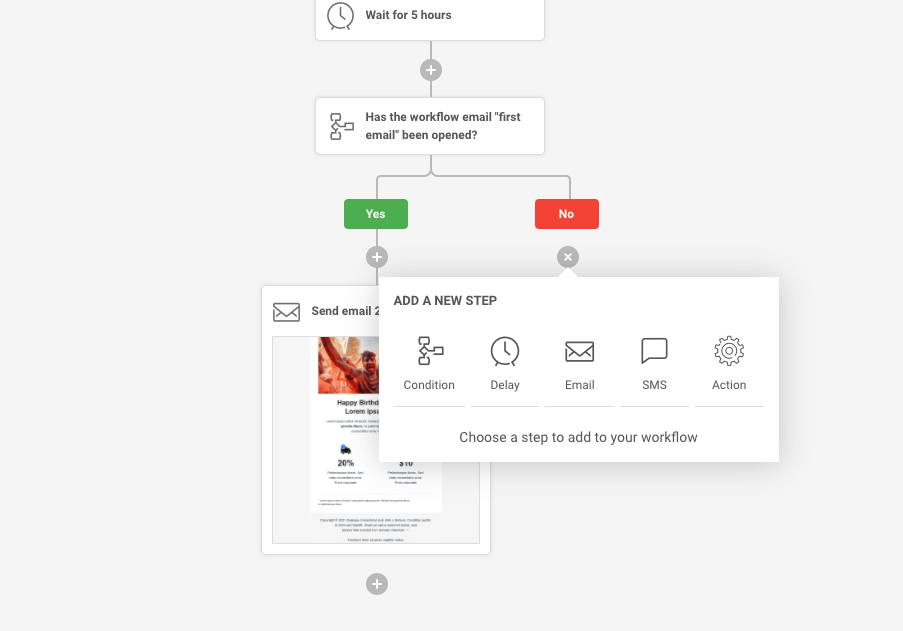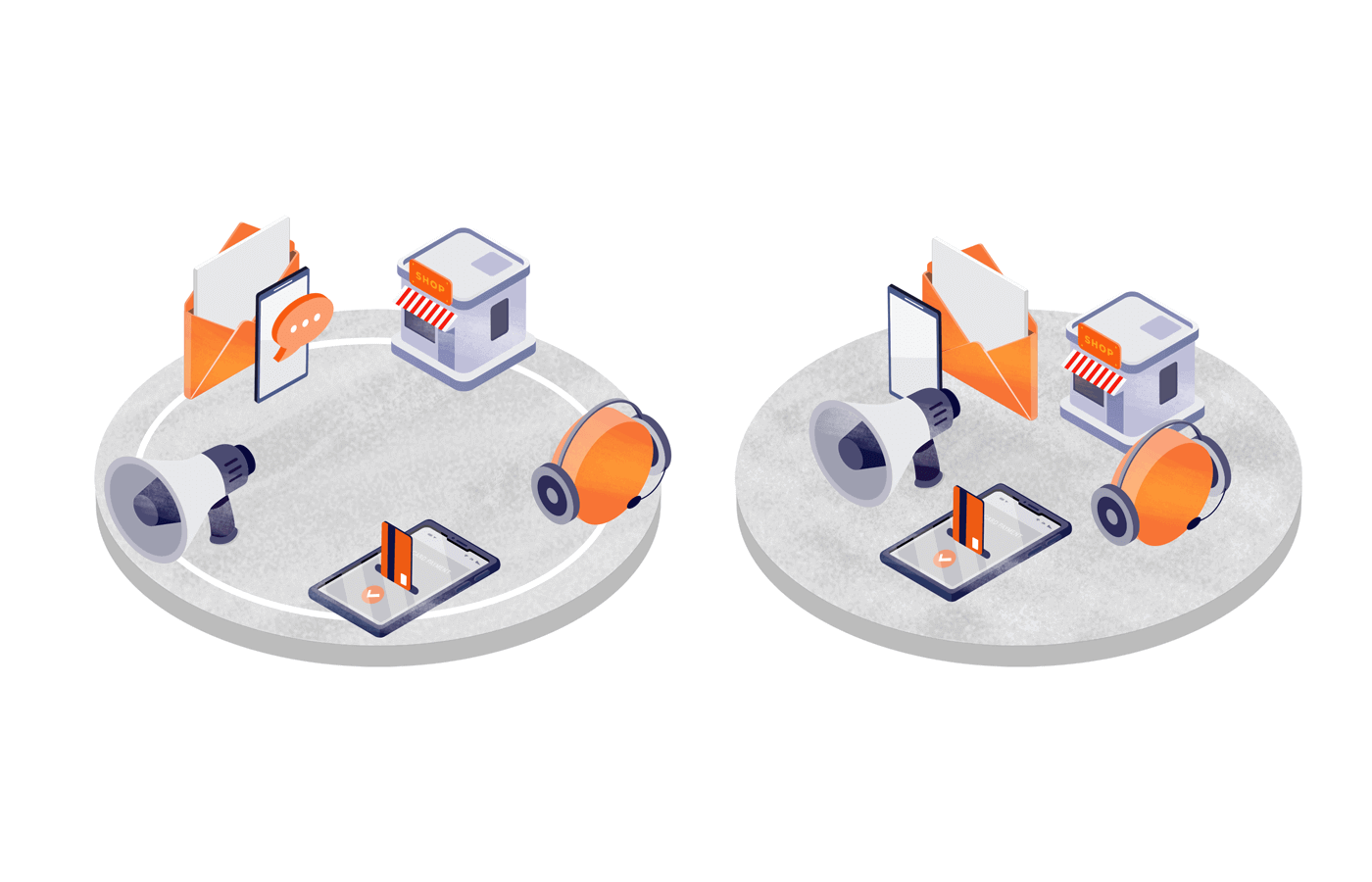With so many customer touchpoints available, the popularity of omnichannel marketing strategies has exploded.
67% of shoppers purchase products online and pick them up in-store, while 44% of consumers prefer to go to a physical store.
To leverage the best of both brick-and-mortar and e-commerce sales, brands are taking an omnichannel approach. Why? It provides seamless touchpoints across all channels.
But wait. There’s another approach to consider: multichannel.
These terms may sound like the same thing, but the two approaches are quite different.
An omnichannel strategy focuses on the customer experience, while multichannel marketing efforts focus more on the channel itself.
In this blog, we’ll cover the key differences between the two marketing strategies to help you decide which one is best for your business.
Definitions: Omnichannel vs. Multichannel
What is omnichannel retail? How does it differ from multichannel retail?
Both approaches can effectively improve the customer experience and drive brand loyalty. It all comes down to how scalable and attainable each one is for your particular business.
What is a Multichannel Approach?
A multichannel selling strategy involves selling or listing products on more than one channel. For example, your business might sell products on an ecommerce website.
You might also have a brick-and-mortar location or post your products on social media platforms like Instagram, TikTok, or Snapchat. This strategy allows you to reach more customers on different channels.
You can make your multichannel retail model part of a multichannel marketing strategy by using email, social media, SMS marketing, or your company’s website to reach customers.
Need inspiration? Take a look at how Olipop sets up its home page for a multichannel approach.

Note: This method won’t offer an integrated experience like an omnichannel model because it focuses on using multiple channels independently to engage with customers rather than creating a seamless and cohesive experience across all platforms.
What is Omnichannel?
Omnichannel strategies aim to create a unified, integrated customer experience, removing silos between touchpoints.
The line between physical stores, social media, email, instant messaging, ads, and other customer touchpoints blurs to create a single view of the customer and a single commerce experience.
Omnichannel marketing brings multiple mediums (e.g., websites, emails, targeted ads, social media marketing, physical locations) together to deliver customers personalized offers, products, and messages.
When it comes to brands that successfully implement omnichannel marketing, Tailor Brands is a great example to look at.
Unified Branding Across Channels
Tailor Brands maintains consistent branding elements, such as logos, color schemes, and messaging, across all marketing channels.
This consistency fosters a seamless customer experience, regardless of whether they engage through social media, email, or the website.

For example, Tailor Brands discussed the steps of formatting the LLC in Florida on their website and on their YouTube channel (among other social media platforms).

Integrated Customer Data
Omnichannel marketing involves centralizing data to create a comprehensive customer profile.
Tailor Brands integrates data from various touchpoints, such as:
- Social media engagement
- Website interactions
- Email responses
Why? To gain a holistic view of individual customer preferences and behavior to provide a consistent customer experience.
With Sender, you can easily create personalized email and text message campaigns without having to switch between apps. You can even combine these two campaigns to give subscribers an omnichannel experience, which further boosts engagement and sales.

Personalized User Experiences
Personalization is a key aspect of omnichannel marketing. Tailor Brands uses customer data to:
- Cater to individual preferences across different channels
- Provide tailored content and recommendations
- Personalize interactions
So, what’s the secret recipe for gathering this goldmine of data?
Implementing session replay within omnichannel and multichannel strategies allows you to capture and analyze user interactions across various touchpoints, providing an understanding of customer behaviors and preferences.

When using session replay, you’ll be able to fine-tune your preferred marketing strategies. This involves refining user experiences, identifying friction points, and optimizing customer journeys across the selected channels.
Session replay is a powerful ally in enhancing omnichannel and multichannel strategies by offering real-time data on user interactions.
As a result, you can align your approach more effectively with evolving customer expectations in 2024.
Benefits of Omnichannel Marketing
To really understand the benefits of omnichannel marketing, consider this example of an omnichannel retail experience:
- Imagine a customer visiting your website and adding one of your products to their cart.
- They don’t complete the purchase.
- You have an email workflow set up that allows you to automatically send that customer an email reminding them that they left something behind.
- You might even offer a discount to incentivize them to complete the purchase.
- The customer sees the email and forgets about it.
- You serve targeted ads to that customer on social media with that same discount. This reminds them about the product and further entices them to take advantage of the offer. They finally made the purchase.
- Your CRM or email marketing software automatically sends a post-purchase email thanking the customer for their purchase and requesting them to review the product.
With that in mind, let’s break down the benefits of this approach:
- Re-engage cold leads: Omnichannel marketing effectively re-engages customers who have shown interest but haven’t completed a purchase. You can gently nudge them back toward making a purchase by tracking their interactions, such as items added to a cart;
- Nurture leads down the sales funnel: Through a series of targeted and personalized communications across platforms, omnichannel marketing guides potential customers further down the sales funnel. The result? An increased likelihood of conversion;
- A personalized, targeted, and data-driven approach: Omnichannel marketing leverages data on customer behavior and preferences collected across multiple touchpoints. This data can help create highly personalized and targeted marketing strategies that resonate more effectively with each customer;
- Channel-agnostic customer engagement: A key aspect of omnichannel marketing is its ability to seamlessly engage customers across all channels. Whether a customer prefers shopping online, through social media, or via email, the experience is consistent and interconnected.
Key Differences Between Omnichannel & Multichannel
Understanding omnichannel vs. multichannel all comes down to recognizing the degree of integration and seamless experience across all customer touchpoints.
A multichannel marketing approach is more channel-based and focuses on customer engagement. It involves managing various channels independently without a fully integrated experience.
Omnichannel marketing focuses on the entire experience. It involves integrated channels, allowing customers to resume interactions across different platforms seamlessly.
You can also think of it like this: Omnichannel means “all channels.”
Let’s look at this example.
In omnichannel retail, a customer:
- Browses a brand’s products online on their smartphone;
- Visits the physical store to try on a few items;
- Connects the online store’s app to their in-store experience;
- Decides to make the final purchase online after receiving personalized recommendations.
In a multichannel retail strategy, where channels operate independently, the same customer:
- Browses a different brand’s products online on their smartphone after seeing an online ad;
- Visits the physical store, where there’s little connection between the online and offline channels;
- Experiences no seamless integration of data.
Omnichannel vs. Multichannel
From more personalized customer experiences to data integration, there are some key differences between omnichannel and multichannel marketing.
Customer Engagement vs. Customer Experience
Multichannel marketing focuses on customer engagement using separate channels.
Omnichannel marketing takes a more customer-centric approach, placing a greater emphasis on the customer experience.
The result is a more seamless, integrated customer journey for customers across all channels.
Let’s take a look at how a personal finance company like SoFi uses omnichannel strategies to provide a cohesive customer experience.
For instance, if a user has shown interest in credit card information, they could see a retargeting ad on Instagram. It takes the user to a landing page that highlights credit card offers, benefits, and other educational content that demystifies the credit card application process.
Then, once a customer has enough information and signs up for a new credit card, they get a personalized email to download the SoFi mobile app.
Integrating these channels to work together cohesively, SoFi provides a unified and personalized customer experience. The result? Increased customer satisfaction and loyalty, and the potential to boost word-of-mouth referrals.
Channel-Centric vs. Customer-Centric
A multichannel strategy is more channel-centric, which means each channel operates independently.
The main goal is maintaining a presence across multiple channels instead of providing a unified experience.
Taking an omnichannel marketing approach results in a more customer-centric sales strategy. The focus is on delivering a consistent and unified experience regardless of the channel.
The key to a successful omnichannel strategy is understanding and meeting the needs of customers throughout their journey.
Quantity vs. Quality
Omnichannel marketing prioritizes quality over quantity rather than engaging as many customers as possible. The aim is to provide the most personalized experiences through data integration.
Multichannel marketing strategies often prioritize quantity. This channel-centric approach aims to use as many channels as possible to interact with customers.
Data Integration
Data integration is often limited to multichannel marketing. Each channel has its own customer information set, resulting in siloed customer data.
Omnichannel marketing seeks to break down data silos by providing a seamless, customer-centric, and integrated journey across all touchpoints. A composable CDP (Customer Data Platform) is key to achieving this.
A composable CDP allows you to integrate data from various marketing channels and sources into a unified customer profile. This unified view empowers marketers to deliver personalized experiences and optimize marketing campaigns across all channels.
Key Takeaways
There’s really no right or wrong answer when it comes to deciding on which marketing strategy is best. The approach you choose will depend on your business goals.
For example, if you want to reach specific brand goals, such as improving customer engagement and increasing brand awareness, then a multichannel approach could help.
An omnichannel strategy may be best if you want to improve the overall customer journey and boost brand loyalty. Here’s what you should keep in mind:
- In a multichannel approach, multiple channels operate independently of each other;
- Omnichannel seamlessly integrates various channels for a unified and consistent experience across all touchpoints;
- Omnichannel strategies focus on the customer journey as a whole;
- Multichannel marketing places an emphasis on having a presence on multiple channels to reach a broader audience.
Want some more insights to rock omnichannel marketing? Check out these articles:
- 11+ Omnichannel Customer Engagement Strategies
- Omnichannel Marketing Automation Strategy: Starter Guide
Author bio
Jeremy is co-founder & CEO at uSERP, a digital PR and SEO agency working with brands like Monday, ActiveCampaign, Hotjar, and more. He also buys and builds SaaS companies like Wordable.io and writes for publications like Entrepreneur and Search Engine Journal.
